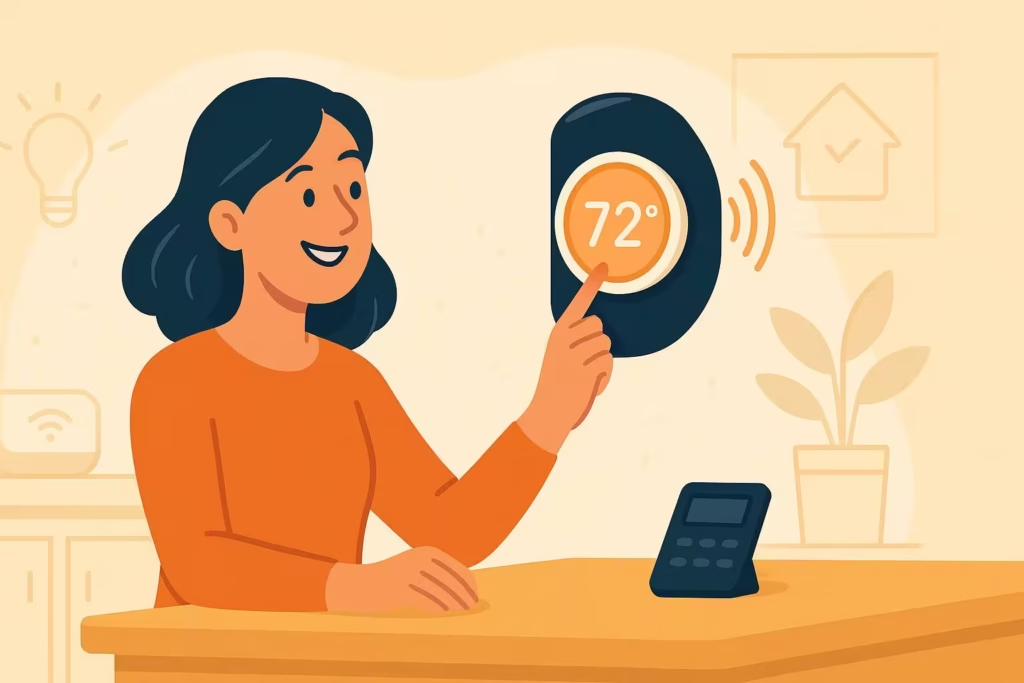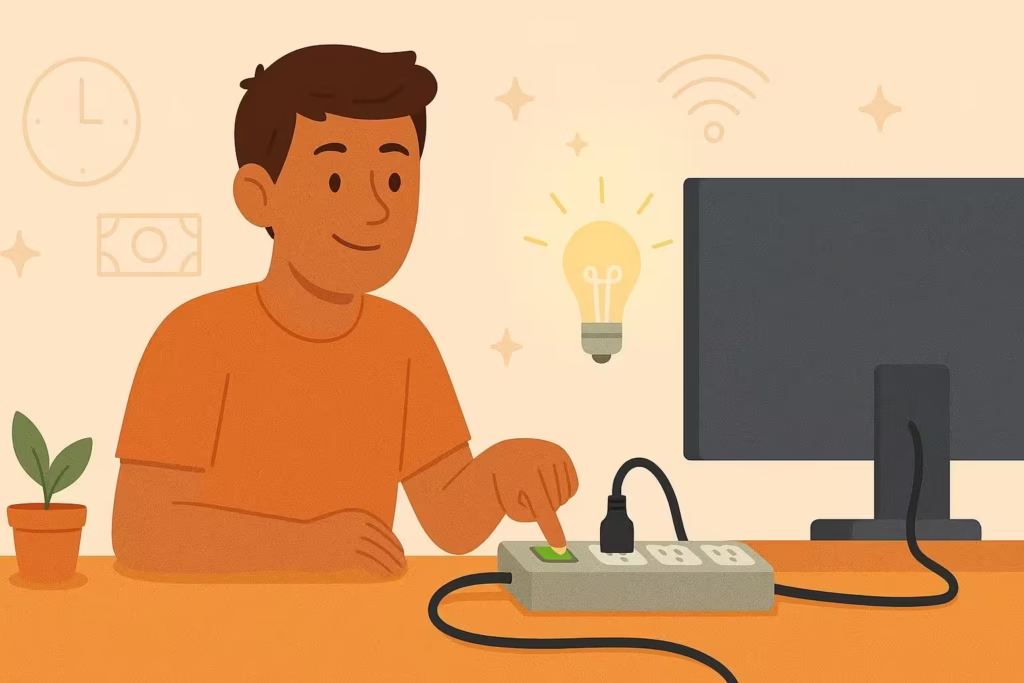Are You Overspending at Home? Let’s Fix That!
Table of Contents
Are you tired of watching your hard-earned Money vanish on home expenses? You’re not alone! Many homeowners unknowingly waste thousands of dollars yearly on energy bills, unnecessary purchases, and overlooked home maintenance costs.
The good news is that with a few thoughtful adjustments, you can significantly cut costs while maintaining (or even improving!) your comfort and convenience.
This guide offers practical tips to cut home expenses without sacrificing comfort.
Let’s dive into actionable strategies to stop wasting Money and start making every dollar count!
Energy Efficiency: Cut Costs Without Sacrificing Comfort
An inefficient home can lead to rapidly increasing energy costs.
The good news is that you can reduce your energy bill by 20-50% just by making a few smart adjustments—without sacrificing comfort.
This section covers:
✔️ Smart thermostats for automated climate control
✔️ LED lighting to cut energy consumption
✔️ Optimized appliance usage for maximum efficiency
Let’s dive in!
Upgrade to Smart Thermostats

Did you know that nearly 50% of your home’s energy bill comes from heating and cooling?
A smart thermostat can drastically cut your energy costs by automatically adjusting your home’s temperature based on your schedule, preferences, and even weather conditions.
Benefits of Smart Thermostats:
✅ Automated Savings – Adjusts temperature automatically based on your habits.
✅ Remote Control – Adjust settings from anywhere via an app.
✅ Energy Reports – Get detailed insights into your energy use.
✅ Geofencing Feature – Lowers or raises temperatures when you leave/return home.
Comparison: Traditional vs. Smart Thermostats
Feature Traditional Thermostat Smart Thermostat
Manual Adjustments Required Daily Auto-Adjusts & Learns Your Routine
Energy Savings Low High (Up to 20-30%)
Remote Control No Yes (Via Mobile App)
Intelligent Scheduling No Yes (AI-Powered Learning)
Cost $20-$50 $100-$250
ROI (Return on Investment) Slow Fast (Pays for itself in ~2 years)
Top Smart Thermostat Recommendations
Looking to save on energy bills while keeping your home perfectly comfortable year-round? These top-rated smart thermostats are packed with features like voice control, learning your preferences, and remote access from anywhere using your phone. Here’s a breakdown of the best options worth checking out:
1. Google Nest Learning Thermostat (3rd Gen)
- No more programming: With Auto-Schedule, the Google Nest Learning Thermostat learns from you and programs itself..Produc…
- Home/Away Assist: don’t heat or cool an empty home. Home/Away Assist adjusts the temperature after you leave.
- Remote control: Control your thermostat from anywhere using the Nest app.
- ✅ Learns your schedule and adjusts automatically
- ✅ Works with Alexa and Google Assistant
- ✅ Sleek design with a bright display
- ✅ Helps save energy by auto-adjusting when you’re away
👉 Check it out on Amazon
2. Ecobee Smart Thermostat Premium
- Save up to 26% per year on heating and cooling costs. ENERGY STAR certified. Included SmartSensor (50 dollar value) adju…
- Built-in air quality monitor alerts you to poor air quality, provides tips on how to improve it, and reminds you when it…
- Premium materials and advanced engineering mean a large, vibrant display with a cinematic interface, a timeless design, …
- ✅ Built-in voice control (Alexa) + Apple HomeKit support
- ✅ Comes with a SmartSensor for more accurate room readings
- ✅ Energy Star certified with advanced scheduling features
👉 View on Amazon
3. Honeywell Home T9 Smart Thermostat
- SAVE MONEY AND ENERGY. Adjust your ENERGY STAR certified thermostat from anywhere with your mobile device, or let your h…
- LIVE AND SLEEP SMARTER. Choose the temperature in a specific room, like the bedroom, to be exactly what you want it to b…
- AMAZING SENSOR RANGE. The battery powered Smart Room Sensors utilize unique Honeywell Home technology to deliver an effi…
- ✅ Great value for multi-room temperature control
- ✅ Works with Smart Room Sensors
- ✅ Compatible with Alexa, Google Assistant, and Cortana
👉 See it on Amazon
4. Amazon Smart Thermostat
- Smart upgrade – Amazon Smart Thermostat is an easy way to switch from a traditional thermostat and help reduce energy us…
- Supports temperature sensors – use compatible Echo devices (Echo Dot (4th and 5th gen), Echo Dot with clock (5th gen)), …
- Save money – After purchase, Amazon will send you an email with details about rebates that may be available from energy …
- ✅ Affordable, simple, and made for Alexa users
- ✅ Easy setup with step-by-step Alexa app guidance
- ✅ ENERGY STAR certified and budget-friendly
👉 Explore on Amazon
Pro Tip: When choosing a smart thermostat, make sure it’s compatible with your HVAC system and smart home setup. If you’re looking for energy savings and automation, any of the options above is a solid pick!
Switch to LED Lighting

You’re wasting energy and money if you’re still using incandescent bulbs. LED bulbs use 75% less energy and last 25 times longer than traditional bulbs.
Why Switch to LED Bulbs?
✅ Instant Savings – Uses 75-80% less energy than incandescent bulbs.
✅ Long Lifespan – Lasts 25,000+ hours vs. 1,200 hours for incandescent.
✅ Cooler Temperature – Produces less heat, keeping rooms cooler.
✅ Eco-Friendly – Reduces carbon footprint and waste.
Comparison: LED vs. Incandescent vs. CFL
Feature Incandescent Bulbs, CFL (Compact Fluorescent), LED Bulbs
Energy Usage High Medium Low (75% less)
Lifespan ~1,200 hours ~8,000 hours ~25,000+ hours
Cost per Bulb $1-$2 $3-$5 $3-$6
Heat Emission High Medium Low
Annual Savings (per bulb) $5-$10 $10-$15 $15-$25
💡 Pro Tip: Prioritize replacing bulbs in high-use areas (living rooms, kitchens, hallways) for immediate energy savings!
Optimize Appliance Usage
Your home appliances quietly drain energy, even when you’re not actively using them. Optimizing when and how you use them can cut your electricity bill significantly.
Energy-Saving Appliance Habits
Appliance: How to Reduce Energy Usage
Refrigerator: For maximum efficiency, keep it 75% complete.
Clean the coils every 6 months.
Set the temperature to 37°F (3°C).
Washing Machine: Wash full loads in cold water (saves up to 90% on energy).
Dishwasher: Use eco mode and let dishes air-dry instead of heat drying.
Water Heater: Lower temperature to 120°F (49°C) to save up to 10% on energy bills.
Oven & Stovetop: Use the microwave or air fryer instead (they use 80% less energy).
Electronics: Unplug devices when not in use to avoid phantom energy drain.
Use Smart Power Strips to Eliminate Phantom Power Drain

Did you know that even when turned off, electronics still consume power? This is called phantom energy drain, and it can cost you $100-$200 per year in wasted electricity.
A smart power strip automatically shuts off power to unused devices, saving energy effortlessly.
Comparison: Regular vs. Smart Power Strips
Feature Regular Power Strip Smart Power Strip
Auto Shut-off No Yes (Detects Idle Devices)
Energy Savings Low High (Prevents Phantom Drain)
Remote Control No Yes (Wi-Fi/App Integration)
Average Cost $10-$20 $30-$50
Annual Savings $0 Up to $150
💡 Pro Tip: Plug in your TV, gaming console, and computer setup into a smart power strip for instant savings!
Weatherproofing to Reduce Heating & Cooling Costs
A drafty home = higher energy bills! Weatherproofing can reduce heat loss by 20-30%, slashing your heating and cooling costs.
How to Weatherproof Your Home:
✅ Seal Windows & Doors – Use weather stripping or draft stoppers.
✅ Add Thermal Curtains – Traps winter heat and blocks summer heat.
✅ Install Door Sweeps – Stops drafts under doors.
✅ Use Insulated Window Film – Prevents heat loss through glass.
💡 Quick Test: On a windy day, hold a candle near windows and doors. If the flame flickers, you have an air leak!
Final Thoughts on Energy Efficiency
Making small but impactful changes can slash your energy bill while keeping your home comfortable.
✔ Start with LED bulbs and smart thermostats for instant savings.
✔ Use smart power strips to stop phantom energy drain.
✔ Weatherproof your home to reduce heating/cooling costs.
💡 What’s Next? Try implementing one change today, and watch your energy savings add up! 🚀
Smart Water Usage: Reduce Waste and Save Money

Install Smart Water Meters
A small leak can waste over 10,000 gallons of water annually! Smart water meters detect leaks early and track real-time water usage.
Feature Traditional Meter Smart Water Meter
Leak Detection No Yes (Instant Alerts)
Water Usage Data No Yes (App-Based Insights)
Monthly Savings Low High (Up to 30%)
Best Smart Water Meters:
- Flume 2 Smart Home Water Monitor
- Govee WiFi Water Leak Detectors
- 24/7 SMART WATER LEAK DETECTOR: Flume’s smart water leak detection technology is always on guard alerting you to water l…
- SMART WATER USAGE MONITORING: Dig up the details your standard water bill doesn’t with Flume’s smart water monitoring te…
- REDUCE & MANAGE YOUR WATER BILL: A smart water monitor that pays for itself. Flume allows you to be proactive about mana…
- Real-time Alerts & Various Notifications: Connect the gateway to WiFi, and the water detector will instantly send emails…
- Connects to Multiple Sensors: This water leak detector is equipped with a powerful WiFi connection gateway, allowing you…
- Drip and Leak Detection: The water sensor alarm with 2 groups of backwater detector probes & 1 group of front probes for…
💡 Pro Tip: If your water bill suddenly spikes, check for silent leaks in toilets and faucets!
Use Water-Efficient Fixtures
Switching to low-flow faucets, showerheads, and toilets can save up to 50% on water bills.
Fixture Standard Model Usage Water-Efficient Model Usage
Showerhead 2.5 GPM 1.5 GPM (Saves 40%)
Toilet 3.5-7 GPF 1.28 GPF (Saves 60%)
Faucet 2.2 GPM 1.5 GPM (Saves 30%)
💡 Pro Tip: Take shorter showers and use a smart water timer to reduce waste.
Final Thoughts: Small Changes, Big Savings
Making your home more cost-efficient doesn’t require a massive lifestyle change.
With minor adjustments—like installing smart thermostats, switching to LED bulbs, using water-efficient fixtures, and leveraging technology—you can save thousands of dollars each year.
The best part? You won’t even notice the difference—except in your bank account!
Start with one change today, and watch your savings grow over time.
FAQ Section: Your Money-Saving Questions Answered
Do smart thermostats save Money?
Absolutely! Smart thermostats, like the Google Nest or Ecobee smart thermostat, can reduce your heating and cooling costs by up to 20% annually.
These devices learn your daily schedule and adjust temperatures accordingly, ensuring you don’t waste energy when you’re away or asleep.
💡 Example: If your monthly energy bill is $150, switching to a smart thermostat could save you around $30 per month or $360 per year!
Are solar panels worth the investment?
Solar panels can be a game-changer for long-term savings, but they’re not a one-size-fits-all solution.
✅ Best for: Homeowners in sunny regions who plan to stay in their homes for 10+ years.
❌ Not ideal for Homes with excessive shade or those planning to move soon.
Factor Pros Cons
Cost Long-term savings High upfront cost ($10,000-$20,000)
ROI Timeframe: 6-10 years Takes time to break even
Energy Bills Reduce/eliminate bills Savings vary by region
Tax Credits Federal and state incentives Availability varies
💡 Tip: Many governments offer tax credits and rebates that can cut installation costs by 30% or more!
What is the easiest way to cut home costs today?
If you want instant savings with minimal effort, start with these three steps:
- Switch to LED bulbs – This simple change can reduce lighting costs by 80%.
- Unplug appliances when not in use – Phantom power can cost you $100+ annually.
- Lower your water heater temperature to 120°F – This minor tweak can cut heating costs by 10%.
Do smart power strips make a difference?
Yes! Many electronics still draw power even when turned off, a phenomenon called phantom energy drain.
💡 Example: Your TV, gaming console, and coffee maker combined may cost you $200 per year in standby power! Smart power strips automatically shut off power to devices when they’re not in use.
🔌 Recommended Smart Power Strips:
- 1. TP-Link Kasa Smart Wi-Fi Power Strip (HS300)
Outlets: 6 individually controllable AC outlets + 3 USB ports
Features: Energy monitoring, surge protection, voice control via Alexa & Google Assistant
Why It Stands Out: Highly rated for its reliability and comprehensive features, making it a favorite among smart home enthusiasts. - TP-Link Kasa Smart Wi-Fi Power Strip (KP303)
Outlets: 3 smart AC outlets + 2 USB ports
Features: Compact design, scheduling, voice control, away mode
Why It Stands Out: Ideal for smaller setups, offering essential smart features in a space-saving design. - GHome Smart Power Strip
Outlets: 3 smart AC outlets + 3 USB ports
Features: Voice control, scheduling, timer functions
Why It Stands Out: Budget-friendly option with essential smart features, suitable for various devices. - Eve Energy Strip
Outlets: 3 AC outlets
Features: HomeKit compatibility, energy monitoring, surge protection
Why It Stands Out: Best choice for Apple HomeKit users seeking seamless integration. - Genki Moonbase Power Strip
Outlets: 3 AC outlets + 4 USB-C ports (up to 240W total)
Features: GaN technology, LED-lit transparent outlets, compact design
Why It Stands Out: Innovative design with high-power USB-C charging, suitable for tech enthusiasts.
Is buying in bulk cheaper?
It depends! While buying in bulk can save Money, it’s essential to be strategic.
✅ Best items to buy in bulk:
- Non-perishable foods (rice, pasta, canned goods)
- Household essentials (toilet paper, detergent)
- Frozen foods (meat, veggies, fruit)
❌ What NOT to buy in bulk:
- Fresh produce (may spoil before use)
- Snacks (can lead to overconsumption)
- Trendy items (may go unused)
💡 Tip: Check the unit price (cost per ounce/pound) to ensure you get a real deal!
How do I know if my home has a water leak?
Hidden leaks can waste thousands of gallons of water per year, increasing your water bill significantly.
Signs you may leak:
- A sudden spike in your water bill 💰
- The sound of running water when no faucets are on 🔊
- Water stains on ceilings or walls 🏠
💡 Easy Test:
- Turn off all water sources in your home.
- Check your water meter before and after an hour.
- If the number changes, you likely have a leak.
Solution: Install a smart water meter like the Flume 2 Smart Home Water Monitor, which detects leaks in real time and alerts you via an app.
What’s the best way to save money on groceries?
Food expenses can add up fast, but a few smart strategies can help you cut grocery costs by 30% or more!
✅ Easy Grocery Savings Tips:
- Plan meals with apps like Mealime or Yummly 📅
- Use cashback apps like Ibotta and Rakuten 💵
- Buy store brands instead of name brands 🛒
- Stick to a shopping list and avoid impulse purchases 📝
- Shop in the evening when stores discount perishables 🏷️
💡 Bonus: Learn proper food storage techniques to extend the life of produce and dairy products!
What home maintenance should I NEVER skip?
Regular maintenance prevents expensive repairs down the road. Here are the top 3 things you should NEVER ignore:
- HVAC Maintenance: Dirty filters can increase your energy bill by 15%! Change filters every 1-3 months and schedule a yearly tune-up.
- Roof & Gutter Cleaning: Clogged gutters can cause water damage—clean them every 6 months to avoid costly repairs.
- Plumbing Checks: Inspect for slow leaks in faucets and pipes to prevent water damage and mold growth.
💡 Tip: Set reminders on your phone for regular maintenance tasks so you don’t forget!
Are home security systems worth the cost?
Yes, and they can actually save you Money in multiple ways!
🔒 Benefits of Smart Security Systems:
- Reduce the risk of break-ins by up to 60%
- Get discounts on home insurance (usually 5-20%)
- Remote monitoring for vacation peace of mind
Best Budget-Friendly Home Security Systems:
- Ring Alarm Security Kit – Affordable and easy DIY installation
- A great fit for 1-2 bedroom homes, this Alarm Kit includes one Base Station, one Keypad, four Contact Sensors, one Motio…
- Includes an intuitive Keypad that can arm and disarm your Alarm and Contact Sensors that detect when doors or windows op…
- Choose the Ring Alarm Kit that fits your needs and detect even more with additional Alarm Sensors and accessories (sold …
- SimpliSafe – No contracts and customizable plans
- Simple to set up. Seriously secure. Get ready to protect right out of the box. Just plug in the Base Station and camera,…
- 1 FREE month of professional monitoring for fast police response when you need it most. With optional monitoring service…
- Complete control of your system with the SimpliSafe App – Arm, disarm and protect anytime, anywhere.
- Wyze Cam – Budget-friendly smart cameras for under $50
- Versatile Security Camera for Home Security: Control this indoor camera remotely via the Wyze app, with 360° pan and 180…
- Durable Outdoor Security Camera (IP65-rated): Built to withstand rain and extreme temperatures (requires Outdoor Power A…
- Advanced Motion-tracking Pet Camera: Automatically locks onto movement—whether it’s a dog, intruder, or family member—an…
How can I make my home more energy-efficient on a budget?
You don’t need expensive upgrades to see actual savings.
Here are five budget-friendly energy hacks:
- Weatherproof your windows with cheap draft stoppers ($10)
- Install LED bulbs in high-use areas ($3 per bulb)
- Use blackout curtains to regulate indoor temperatures ($20-$40)
- Set ceiling fans to spin clockwise in winter & counterclockwise in summer
- Unplug “energy vampires” like chargers, gaming consoles, and coffee makers
💡 Pro Tip: Small energy-efficient changes add up—over time, you can save hundreds of dollars annually!
Final Thoughts on Saving Money at Home:
Whether it’s reducing energy waste, cutting grocery costs, or preventing expensive home repairs, small changes can add up to thousands of dollars in savings per year.
Start implementing one or two of these strategies today, and gradually build smart habits to help your bank account grow!










